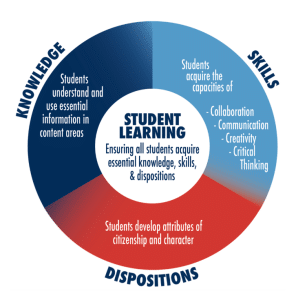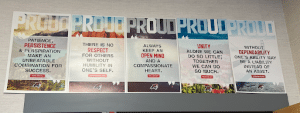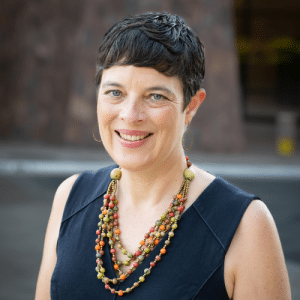Shifting to PCBL with Intentionality at a Large High School
CompetencyWorks Blog
How does a big school make the transition to personalized, competency-based learning? The same way that any learning community makes the shift! It’s through leadership, a shared vision, strategic communication, a learning mindset, a culture of belonging, analyzing policies and practices, and working collaboratively and iteratively to align them to your vision and the principles of competency-based education. Still, this question kept bubbling for me during my time in Utah, where three of the four schools I spent time in had over 2,000 students each. This post captures the story of American Fork High School (AFHS) in Alpine School District, which serves around 2,400 students in grades 10-12.

The Alpine School District Vision for Learning, created in 2016, drives the focus in the district. Blaine Edman, the Director of Technology for the district (and lead for the district’s PCBL grant), explains how different elements of student-centered practice connect to the Vision for Learning, saying that “competency, personalized, deeper, blended all have an overlap. And then our Vision for Learning falls right in the middle of where that overlap is. So if you’re pursuing the Vision for Learning, you can pursue it through a competency-based lens or through a deeper learning lens or through a blended lens. But let’s look for where those lenses all overlap because that’s probably the richest place. AFHS, which has leveraged the Utah Personalized, Competency-Based Learning (PCBL) framework, offers an example of one school’s approach.
Using the Utah PCBL Framework to Drive the Vision
In 2022, Assistant Principal (and 2016 Utah Teacher of the Year and 2024 Utah Assistant Principal of the Year) Melody Apezteguia found herself as the only administrator at AFHS with firsthand longitudinal knowledge. She recalled that, “It had been a good six or seven years since we’d looked at our vision and values statements. We’re a school that uses those as our driver, and we’ve made significant progress from the point at which we’d had that conversation. We had started to feel like we had a lot of things going on. And it was time for us to bring these in and talk about an umbrella, a framework that can guide our work as a school…The Utah PCBL Framework gave [us] a comprehensive way to look at our school and ensure that we were covering all of the bases.” The six elements of demonstrated competency and assessment, culture of learning, social-emotional learning, learner agency, customized supports, and equity all felt important to revisit and they were all in the framework (note, that in later iterations of the framework, equity was shifted to be integrated throughout).
 The way the AFHS team created a process for exploring the PCBL Framework shows how state guidance and resources can support local schools in navigating their own journey to meet their mission. The leadership team – including the administrators plus the lead counselor, innovation coach, and teacher representatives – agreed that it was time to revisit their vision, and they wanted it to be an inclusive process. Teacher leadership and collaboration with teachers is more than a refrain at AFHS, where 40 of 90 full-time teachers have some formal leadership role, from department chairs to intervention team members. The leadership team started by creating “data sheets” for each of the six areas in the PCBL framework. The data sheets included AFHS data – from stakeholder feedback surveys to assessment data – along with the state information and key quotes from research and practice information about each domain.
The way the AFHS team created a process for exploring the PCBL Framework shows how state guidance and resources can support local schools in navigating their own journey to meet their mission. The leadership team – including the administrators plus the lead counselor, innovation coach, and teacher representatives – agreed that it was time to revisit their vision, and they wanted it to be an inclusive process. Teacher leadership and collaboration with teachers is more than a refrain at AFHS, where 40 of 90 full-time teachers have some formal leadership role, from department chairs to intervention team members. The leadership team started by creating “data sheets” for each of the six areas in the PCBL framework. The data sheets included AFHS data – from stakeholder feedback surveys to assessment data – along with the state information and key quotes from research and practice information about each domain.
The data sheets allowed teachers and other staff to learn about each domain and connect it to their past work and current status. Their Student House of Representatives – composed of one student representative from every second-period class – also met to learn and give feedback. For each group, in the relevant domains, they asked:
 How far down the road have we traveled?
How far down the road have we traveled? - What are our strengths? What are things that we’re currently doing?
- What do you see as gaps and weaknesses?
- What do you think are our next steps?
- What are our spaces or opportunities for growth?
From this information, the leadership created a vision statement and collective commitments for each domain. These include vision statements such as, “Our learning culture: we’re brave enough to learn,” with collective commitments such as, “We have high expectations for our students. We collaboratively use evidence to examine and improve ourselves” or for learner agency, “We provide every student meaningful choices in the pursuit of an education they value.” Apezteguia reiterated that it is a forward-looking vision, and not current reality, but they have a vision and a plan. They closed the 2021-2022 school year with a professional development day to engage with the PCBL vision and asked teachers where they should move first, which generated their school goals and milestones. Michael Snyder, Innovative Learning Coach, adds that throughout the process, a key has been to help our teachers “see the why and feel like they’ve been a part of it.”

Entry Points: Technology and Standards-Based Grading
The shift to PCBL was unfolding alongside a shift in technology with the rollout of one-to-one Chromebooks, which had already primed educators’ mindset around changes in pedagogical practices. This helped open up space for shifting to competency-based practices in addition to shifts around technology. Even though they are both big changes, they worked in concert to mutually reinforce each other.
Additionally, with the earlier launch of the district-wide Alpine Vision of Learning, AFHS had begun shifting to standards-based grading for academic goals, which had anchored their efforts and continues to be a springboard for a fuller shift to PCBL. Edman reflects that building a philosophy of grading where “grades reflect what students know, not how compliant they were with the rules that I set up for grading…is really moving the needle in classroom practice, as much or more than anything here.”
Teachers and students value clarity in grading practices. In Apezteguia’s words, “clear is kind,” and this helps them to envision the potential of PCBL, even when Edman notes that “the community is very much set on traditional grading” when it comes to report cards and transcripts. Apezteguia describes that, “it was wonderful and beautiful to see the natural progression as we got better and teachers started to ask themselves, ‘what is this grade representing?’” While progress slowed a bit through COVID, by 2022-23 they were leading the way – with district support – with three groups of teachers piloting a standards-based grade book in their student information system. In addition to grading guidelines that focus on evidence of learning rather than behavior and compliance, there are opportunities for reassessment and flex time for getting extra support, which starts to bridge into other aspects of PCBL.
For example, some teachers use the AFHS P.R.O.U.D. values – persistent, respectful, open-minded, unified, and dependable – and the district-adopted 6Cs – creativity, critical thinking, collaboration, communication, citizenship, and character – to develop transferable skills and dispositions. The school shares about the P.R.O.U.D. behaviors in administrator-created videos shown on Thursdays throughout the year. Some classrooms use the P.R.O.U.D. values as reflection tools and for individual goal setting, which teachers include as part of a dependability grade that is reported separately. In some classrooms, the 6Cs are embedded as part of the student work expectations, too. These classes use content as the vehicle to develop the 6Cs skills and dispositions and a portfolio approach to grade them separately.
 Focusing on Learning Goals
Focusing on Learning Goals
Student and teacher clarity around the learning goals provides a foundation for a CBE system. While much of what is visible at AFHS looks like a traditional comprehensive high school, I saw evidence of a focus on learning in the classrooms I visited. The students could explain what they were doing. In a science class, students were taking notes in their journals as the teacher prepared two solutions to observe as part of a demonstration. In one English class, students peer-reviewed slide decks that synthesized the themes of different novels (including Moby Dick, Pride and Prejudice, and The Count of Monte Cristo, among others) that they read in book groups. In another English class, students finalized 55 word stories that incorporated pauses, a rise in tone, and other features. While we were there, they started to move into practice groups and later, they would be scored on their performance. In an American Sign Language class, students watched videos of and took notes about vocabulary words that they would use in the next class to tell stories in the past tense where something didn’t go as planned (such as a flat tire on the way somewhere) as part of an “IPA” – an integrated performance assessment.
Supporting Teacher Learning

Now, all professional learning at AFHS is tied to the school’s vision, commitments, and milestones to create a coherent vehicle for learning and change across the whole staff. In addition to professional learning days, they have learning lunches centered around different PCBL topics. Instructional coaches run onboarding professional learning meetings to support first- through third-year teachers and teachers with experience who are new to AFHS. The meetings also all tie back to specific domains and commitment statements they are trying to move and grow toward.
The school also mainly uses its Utah PCBL Implementation grant to create professional learning resources. Snyder and Apezteguia were part of a team that designed a job-embedded PCBL course that includes coaching and a stipend for teachers who participate. It provides an introduction to what competency-based learning is, how it fits with the state frameworks, and the district Vision for Learning. Participants design a competency-based unit to implement in their classroom with a coach to reflect about the experience. This functions as a strategic investment in a large district with around 84,000 students where a $100,000 grant can seem small for making sustainable change.
Coherent, Intentional Change
The work at AFHS is in progress, but they have a large crew of administrators, staff, and students moving in a clear direction. Within the district, they stand out as a leader because they have created a coherent vision and plan for change. It is a vision and plan that staff own and that is aligned with the district vision. AFHS shows that it’s possible to be aligned with the broader system, while also adding your own touch.

Learn More
- Metaphors for Change from Timpanogos High School
- Utah’s Launchpad to Personalized, Competency-Based Learning
- Beyond the Traditional Transcript: State Policy Recommendations for Next Gen Credentials
- Implementation with Integrity
 Laurie Gagnon is the CompetencyWorks Program Director at the Aurora Institute. She leads the work of sharing promising practices shaping the future of K-12 personalized, competency-based education (CBE). While in Utah for the first Magellan Summit on Personalized, Competency-Based Learning (PCBL) in January 2023, she had the opportunity to talk to school leaders from American Fork High School.
Laurie Gagnon is the CompetencyWorks Program Director at the Aurora Institute. She leads the work of sharing promising practices shaping the future of K-12 personalized, competency-based education (CBE). While in Utah for the first Magellan Summit on Personalized, Competency-Based Learning (PCBL) in January 2023, she had the opportunity to talk to school leaders from American Fork High School.